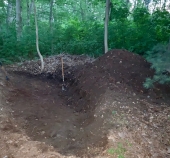





 When getting soil involves transportation via automobile, I think sometimes it makes sense to simply use water.
When getting soil involves transportation via automobile, I think sometimes it makes sense to simply use water. 



Brenda
Bloom where you are planted.
http://restfultrailsfoodforestgarden.blogspot.com/




[img]http://i109.photobucket.com/albums/n52/havlik1/permie%20pics2/permiepotrait3pdd.jpg[/img]
"One cannot help an involuntary process. The point is not to disturb it. - Dr. Michel Odent




Brenda
Bloom where you are planted.
http://restfultrailsfoodforestgarden.blogspot.com/









Missoula Massage












Missoula Massage




Buy Our Book! Food Web: Concept - Raising Food the Right Way. Learn make more food with less inputs
Off Grid Homesteading - latest updates and projects from our off grid homestead




 http://www.aquaponics.net.au/aqua1/
http://www.aquaponics.net.au/aqua1/Idle dreamer




Buy Our Book! Food Web: Concept - Raising Food the Right Way. Learn make more food with less inputs
Off Grid Homesteading - latest updates and projects from our off grid homestead




Idle dreamer








Aquaponcs is a major water savings over regular fish farming.
Buy Our Book! Food Web: Concept - Raising Food the Right Way. Learn make more food with less inputs
Off Grid Homesteading - latest updates and projects from our off grid homestead








Buy Our Book! Food Web: Concept - Raising Food the Right Way. Learn make more food with less inputs
Off Grid Homesteading - latest updates and projects from our off grid homestead








Idle dreamer








Idle dreamer








Buy Our Book! Food Web: Concept - Raising Food the Right Way. Learn make more food with less inputs
Off Grid Homesteading - latest updates and projects from our off grid homestead









Idle dreamer





Idle dreamer




The ultimate goal of farming is not the growing of crops, but the cultivation and perfection of human beings. - Masanobu Fukuoka




velacreations wrote:
Emerson - carrots and radishes are decent calorie producers (not great, but decent) but the rest of the veggies are not good sources of calories, they should be considered vitamin and mineral sources.
For calories, you need something that is not a fruit, like nuts, tubers, grains, etc. And I don't see those sorts of things being grown in a hydro or aquaponics system.
Peppers have very little calories, but tons of vitamins. Same with tomatoes.




Buy Our Book! Food Web: Concept - Raising Food the Right Way. Learn make more food with less inputs
Off Grid Homesteading - latest updates and projects from our off grid homestead








Buy Our Book! Food Web: Concept - Raising Food the Right Way. Learn make more food with less inputs
Off Grid Homesteading - latest updates and projects from our off grid homestead








velacreations wrote:
sugar is empty calories, and even then, tomatoes and peppers are nothing compared to tubers and nuts.
You are going to need a lot of tomatoes to equal the same calories as a potato.





Pouletic wrote:
The main drawback of aquaponics in most parts of US is that there aren't any species of fish suited for low-input operation (meaning no need to restock or buy/prepare high-protein feed) to get reasonable production of edible fish. After a lot of study about the process, i concluded that the only setup that i would consider worthwhile would be one that uses tilapia.

Idle dreamer




Ludi Ludi wrote:
How do you feel about Bluegill? Feed could be homegrown earthworms and black soldier fly larvae, which are easy to raise at home (they raise themselves, basically).




 I guess one has to weigh the difficulty of keeping the Tilapia at the proper warm temperature versus the difficulty of providing food for a carnivorous fish. I'm looking at Bluegill because they live in both warm and cold water, and will breed in captivity. My other choice was Channel Catfish but they are hard to breed in captivity. Neither of these grows as fast as Tilapia, to my knowledge.
I guess one has to weigh the difficulty of keeping the Tilapia at the proper warm temperature versus the difficulty of providing food for a carnivorous fish. I'm looking at Bluegill because they live in both warm and cold water, and will breed in captivity. My other choice was Channel Catfish but they are hard to breed in captivity. Neither of these grows as fast as Tilapia, to my knowledge.Idle dreamer




Ludi Ludi wrote:I guess one has to weigh the difficulty of keeping the Tilapia at the proper warm temperature versus the difficulty of providing food for a carnivorous fish. I'm looking at Bluegill because they live in both warm and cold water, and will breed in captivity.






Idle dreamer








Emerson White wrote:
Oh it takes so much to heat a greenhouse though.
Idle dreamer

|
moose poop looks like football shaped elk poop. About the size of this tiny ad:
Rocket Mass Heater Resources Wiki
https://permies.com/w/rmh-resources
|
.jpg)





